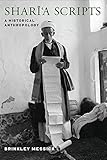Sharīa scripts : an historical anthropology : Yemen under the last imams / Brinkley Messick.
Material type: TextPublication details: New York : Columbia University Press, (c)2018.Description: 1 online resourceContent type:
TextPublication details: New York : Columbia University Press, (c)2018.Description: 1 online resourceContent type: - text
- computer
- online resource
- 9780231541909
- Yemen under the last imams
- Justice, Administration of -- Yemen (Republic) -- History -- 20th century
- Law reform -- Yemen (Republic) -- History -- 20th century
- Islamic law -- Yemen (Republic) -- History -- 20th century
- Zaydīyah -- Yemen (Republic) -- History -- 20th century
- Legal documents (Islamic law) -- Yemen (Republic) -- History -- 20th century
- Legal documents -- Yemen (Republic) -- History -- 20th century
- KMX1046 .S537 2018
- COPYRIGHT NOT covered - Click this link to request copyright permission: https://lib.ciu.edu/copyright-request-form
| Item type | Current library | Collection | Call number | URL | Status | Date due | Barcode | |
|---|---|---|---|---|---|---|---|---|
 Online Book (LOGIN USING YOUR MY CIU LOGIN AND PASSWORD)
Online Book (LOGIN USING YOUR MY CIU LOGIN AND PASSWORD)
|
G. Allen Fleece Library ONLINE | Non-fiction | KMX1046.8 (Browse shelf(Opens below)) | Link to resource | Available | on1017990437 |
Browsing G. Allen Fleece Library shelves, Shelving location: ONLINE, Collection: Non-fiction Close shelf browser (Hides shelf browser)
Includes bibliographies and index.
Introduction -- Library -- Books -- Pretext : five sciences -- Commentaries: "write it down" -- Opinions -- "Practice with writing" -- Archive -- Intermission -- Judgments -- Minutes -- Moral stipulations -- Contracts -- Postscript.
In the first half of Sharī.Aa Scripts, Messick looks at the principal types of theoretical or doctrinal juridical texts, which are collectively referred to as the "library," while those of the second half, including the genres produced by the sharī.Aa courts and by notarial writers, are termed the "archive." Messick demonstrates the analytic significance of sustained attention to the textual form of written sources such as the doctrinal works, juridical opinions, court records and legal instruments studied here. He suggests that attention to form should be a precondition for wider research, for properly assessing the import of conventional source content, for the writing of history. Messick looks at historical sharī.Aa through a particular instance, that of highland Yemen in the first half of the twentieth century. Yemen, of course, is an integral region of the Arabic-speaking heartlands of Islam, and the Zaydī school of jurisprudence that is the specific focus of the book has been rooted there for a millennium. Elsewhere in the same period, colonial regimes and nationalist reformers had begun to alter the political, societal and epistemic existence of the sharī.Aa. They acted to replace its criminal, commercial and real estate provisions with western law, and effectively narrowed its sphere of relevance to matters of personal status and family law. In contrast, under the twentieth-century Zaydī imams the sharī.Aa remained uncodified; highland sharī.Aa courts maintained their historically broad competence; madrassa-trained judges employed classical sharī.Aa rules of procedure and evidence; and archives had yet to upended by western-style standards of file-keeping and printed forms.
COPYRIGHT NOT covered - Click this link to request copyright permission:
There are no comments on this title.







